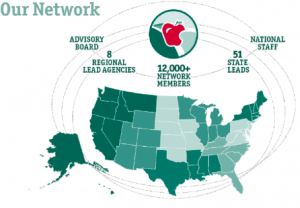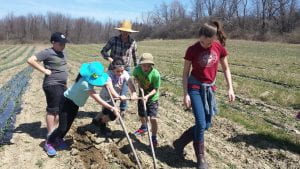Farm to School – One Health in Policy & Practice

Farm to school programs are rapidly gaining popularity as public health nutrition interventions in the United States. These programs provide fresh, whole food choices for cafeterias, classroom snacks, before- and after-school programs, early childhood centers, and summer meal sites. There are clear benefits to providing healthy, nutritious food options to students in schools, where many students eat between 35-50 percent of their daily calories. Childhood obesity and correlating chronic disease outcomes, representing the U.S. medical industry’s most costly public health concerns, can be mitigated by improving food and nutrition security among our nation’s youth and families.
 The comprehensive benefits of these programs extend beyond nutrition and human health. Farm to school programs are a leading example of systems thinking and a One Health perspective applied to public health. These programs connect students to their food choices through hands-on field trips and school garden programs. Students experience the connection between the earth (as an ecosystem of plants, animals, soil, and microorganisms), food, and human health, and relate these connections to what they learn, eat, and do in school. Farm to school is therefore about more than human health—it’s about empowering entire generations to understand the food system as a resource for societal and environmental progress.
The comprehensive benefits of these programs extend beyond nutrition and human health. Farm to school programs are a leading example of systems thinking and a One Health perspective applied to public health. These programs connect students to their food choices through hands-on field trips and school garden programs. Students experience the connection between the earth (as an ecosystem of plants, animals, soil, and microorganisms), food, and human health, and relate these connections to what they learn, eat, and do in school. Farm to school is therefore about more than human health—it’s about empowering entire generations to understand the food system as a resource for societal and environmental progress.
 Farm to school programs have gained traction quickly over the past two decades. Today, over 42,000 schools (42 percent of schools) and 23 million students are engaged in farm to school programs in the United States, compared with only a handful of schools twenty years ago. A main driver of this growth has been the development of the National Farm to School Network (NFSN), “an information, advocacy and networking hub for communities working to bring local food sourcing and food and agriculture education into school systems and early care and education settings.” NFSN has led the charge for promoting farm to school in public food service and educational settings for youth across the country. They grew as a coalition of state and federal agency leads and have become increasingly powerful in policy arenas.
Farm to school programs have gained traction quickly over the past two decades. Today, over 42,000 schools (42 percent of schools) and 23 million students are engaged in farm to school programs in the United States, compared with only a handful of schools twenty years ago. A main driver of this growth has been the development of the National Farm to School Network (NFSN), “an information, advocacy and networking hub for communities working to bring local food sourcing and food and agriculture education into school systems and early care and education settings.” NFSN has led the charge for promoting farm to school in public food service and educational settings for youth across the country. They grew as a coalition of state and federal agency leads and have become increasingly powerful in policy arenas.
 Here in Tompkins County, home to Cornell University, farm to school programs are growing quickly as well. While there is a rich agricultural landscape and strong local food movement in the region, school districts have only recently begun to connect with local farms for meals, snacks, and integrated educational opportunities, due largely to the relative expense of local food and the entrenched norms of purchasing ingredients from industrial food companies and government commodity programs. An average school meal costs about $2.75, of which only $1.00 is spent on food.
Here in Tompkins County, home to Cornell University, farm to school programs are growing quickly as well. While there is a rich agricultural landscape and strong local food movement in the region, school districts have only recently begun to connect with local farms for meals, snacks, and integrated educational opportunities, due largely to the relative expense of local food and the entrenched norms of purchasing ingredients from industrial food companies and government commodity programs. An average school meal costs about $2.75, of which only $1.00 is spent on food.
A network of service agencies in Tompkins County work with school food service leaders and administrators to help address these barriers. The Youth Farm Project is a regional leader in food justice education and farm-based school field trips, and is home to the Fresh Snack Program, which serves locally grown fruits and vegetables as classroom snacks each week to over 1,200 students in four elementary schools facing higher levels of food insecurity.
 The farm to school movement has seen success because of its comprehensive, community-based approach that builds support webs at local, regional, and national levels. While so much of the work is grassroots, it also depends on partnerships with school districts and encouragement from state and federal agencies and legislatures. The Obama administration’s policies have helped to catalyze national appreciation for this One Health approach to public health nutrition—we can only hope the next administration will continue the trend.
The farm to school movement has seen success because of its comprehensive, community-based approach that builds support webs at local, regional, and national levels. While so much of the work is grassroots, it also depends on partnerships with school districts and encouragement from state and federal agencies and legislatures. The Obama administration’s policies have helped to catalyze national appreciation for this One Health approach to public health nutrition—we can only hope the next administration will continue the trend.
This article was written by Audrey Baker (BS ’09, MPA ’14), Cornell MPH Accreditation and Evaluation Specialist and Farm to School Coordinator at the Youth Farm Project.
